Kinetic structure of large-conductance Ca2+-activated K+ channels suggests that the gating includes transitions through intermediate or secondary states. A mechanism for flickers
- PMID: 9607935
- PMCID: PMC2217154
- DOI: 10.1085/jgp.111.6.751
Kinetic structure of large-conductance Ca2+-activated K+ channels suggests that the gating includes transitions through intermediate or secondary states. A mechanism for flickers
Abstract
Mechanisms for the Ca2+-dependent gating of single large-conductance Ca2+-activated K+ channels from cultured rat skeletal muscle were developed using two-dimensional analysis of single-channel currents recorded with the patch clamp technique. To extract and display the essential kinetic information, the kinetic structure, from the single channel currents, adjacent open and closed intervals were binned as pairs and plotted as two-dimensional dwell-time distributions, and the excesses and deficits of the interval pairs over that expected for independent pairing were plotted as dependency plots. The basic features of the kinetic structure were generally the same among single large-conductance Ca2+-activated K+ channels, but channel-specific differences were readily apparent, suggesting heterogeneities in the gating. Simple gating schemes drawn from the Monod- Wyman-Changeux (MWC) model for allosteric proteins could approximate the basic features of the Ca2+ dependence of the kinetic structure. However, consistent differences between the observed and predicted dependency plots suggested that additional brief lifetime closed states not included in MWC-type models were involved in the gating. Adding these additional brief closed states to the MWC-type models, either beyond the activation pathway (secondary closed states) or within the activation pathway (intermediate closed states), improved the description of the Ca2+ dependence of the kinetic structure. Secondary closed states are consistent with the closing of secondary gates or channel block. Intermediate closed states are consistent with mechanisms in which the channel activates by passing through a series of intermediate conformations between the more stable open and closed states. It is the added secondary or intermediate closed states that give rise to the majority of the brief closings (flickers) in the gating.
Figures
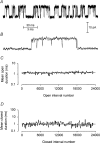
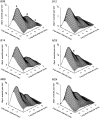
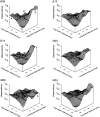


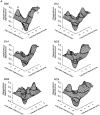







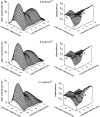


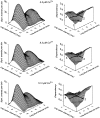














Similar articles
-
Gating kinetics of single large-conductance Ca2+-activated K+ channels in high Ca2+ suggest a two-tiered allosteric gating mechanism.J Gen Physiol. 1999 Jul;114(1):93-124. doi: 10.1085/jgp.114.1.93. J Gen Physiol. 1999. PMID: 10398695 Free PMC article.
-
Voltage and Ca2+ activation of single large-conductance Ca2+-activated K+ channels described by a two-tiered allosteric gating mechanism.J Gen Physiol. 2000 Jul 1;116(1):75-99. doi: 10.1085/jgp.116.1.75. J Gen Physiol. 2000. PMID: 10871641 Free PMC article.
-
High Ca2+ concentrations induce a low activity mode and reveal Ca2(+)-independent long shut intervals in BK channels from rat muscle.J Physiol. 1996 Jun 15;493 ( Pt 3)(Pt 3):673-89. doi: 10.1113/jphysiol.1996.sp021414. J Physiol. 1996. PMID: 8799891 Free PMC article.
-
Allosteric gating of a large conductance Ca-activated K+ channel.J Gen Physiol. 1997 Sep;110(3):257-81. doi: 10.1085/jgp.110.3.257. J Gen Physiol. 1997. PMID: 9276753 Free PMC article.
-
Calcium-activated potassium channels: regulation by calcium.J Bioenerg Biomembr. 1991 Aug;23(4):537-60. doi: 10.1007/BF00785810. J Bioenerg Biomembr. 1991. PMID: 1917908 Review.
Cited by
-
Statistical evaluation of ion-channel gating models based on distributions of log-likelihood ratios.Biophys J. 2006 May 15;90(10):3523-45. doi: 10.1529/biophysj.105.075135. Epub 2006 Feb 3. Biophys J. 2006. PMID: 16461404 Free PMC article.
-
Voltage- and cold-dependent gating of single TRPM8 ion channels.J Gen Physiol. 2011 Feb;137(2):173-95. doi: 10.1085/jgp.201010498. J Gen Physiol. 2011. PMID: 21282398 Free PMC article.
-
Structural basis of voltage-dependent gating in BK channels.Nat Commun. 2025 Jul 1;16(1):5846. doi: 10.1038/s41467-025-60639-y. Nat Commun. 2025. PMID: 40593533 Free PMC article.
-
Allosteric voltage gating of potassium channels I. Mslo ionic currents in the absence of Ca(2+).J Gen Physiol. 1999 Aug;114(2):277-304. doi: 10.1085/jgp.114.2.277. J Gen Physiol. 1999. PMID: 10436003 Free PMC article.
-
How much does TRPV1 deviate from an ideal MWC-type protein?Biophys J. 2024 Jul 16;123(14):2136-2144. doi: 10.1016/j.bpj.2024.04.005. Epub 2024 Apr 6. Biophys J. 2024. PMID: 38582967 Free PMC article.
References
-
- Ackers GK, Doyle ML, Myers D, Daugherty MA. Molecular code for cooperativity in hemoglobin. Science. 1992;255:54–63. - PubMed
-
- Adelman JP, Shen E, Kavanaugh MP, Warren RA, Wu Y, Lagrutta A, Bond C, North RA. Calcium-activated potassium channels expressed from cloned complementary DNAs. Neuron. 1992;9:209–216. - PubMed
-
- Atkinson NS, Robertson GA, Ganetzky B. A component of calcium-activated potassium channels encoded by the Drosophila slo locus. Science. 1991;253:551–555. - PubMed
-
- Ball FG, Sansom MSP. Ion-channel gating mechanisms: model identification and parameter estimation from single channel recordings. Proc R Soc Lond B Biol Sci. 1989;236:385–416. - PubMed
Publication types
MeSH terms
Substances
Grants and funding
LinkOut - more resources
Full Text Sources
Miscellaneous

